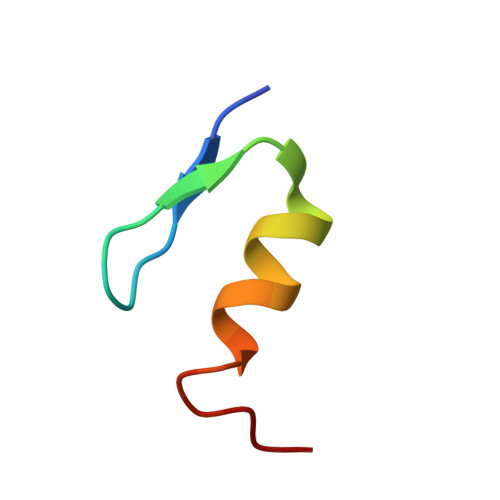Why zinc fingers prefer zinc: ligand-field symmetry and the hidden thermodynamics of metal ion selectivity
Lachenmann, M.J., Ladbury, J.E., Dong, J., Huang, K., Carey, P., Weiss, M.A.(2004) Biochemistry 43: 13910-13925
- PubMed: 15518539
- DOI: https://doi.org/10.1021/bi0491999
- Primary Citation of Related Structures:
1XF7 - PubMed Abstract:
The zinc finger, a motif of protein-nucleic acid recognition broadly conserved among eukaryotes, is a globular minidomain containing a tetrahedral metal-binding site. Preferential coordination of Zn(2+) (relative to Co(2+)) is proposed to reflect differences in ligand-field stabilization energies (LFSEs) due to complete or incomplete occupancy of d orbitals. LFSE predicts that the preference for Zn(2+) should be purely enthalpic in accord with calorimetric studies of a high-affinity consensus peptide (CP-1; Blasie, C. A., and Berg, J. (2002) Biochemistry 41, 15068-73). Despite its elegance, the general predominance of LFSE is unclear as (i) the magnitude by which CP-1 prefers Zn(2+) is greater than that expected and (ii) the analogous metal ion selectivity of a zinc metalloenzyme (carbonic anhydrase) is driven by changes in entropy rather than enthalpy. Because CP-1 was designed to optimize zinc binding, we have investigated the NMR structure and metal ion selectivity of a natural finger of lower stability derived from human tumor-suppressor protein WT1. Raman spectroscopy suggests that the structure of the WT1 domain is unaffected by interchange of Zn(2+) and Co(2+). As in CP-1, preferential binding of Zn(2+) (relative to Co(2+)) is driven predominantly by differences in enthalpy, but in this case the enthalpic advantage is less than that predicted by LFSE. A theoretical framework is presented to define the relationship between LFSE and other thermodynamic factors, such as metal ion electroaffinities, enthalpies of hydration, and the topography of the underlying folding landscape. The contribution of environmental coupling to entropy-enthalpy compensation is delineated in a formal thermodynamic cycle. Together, these considerations indicate that LFSE provides an important but incomplete description of the stringency and thermodynamic origin of metal-ion selectivity.
- Department of Biochemistry, Case Western Reserve University, 10900 Euclid Avenue, Cleveland, Ohio 44106-4935, USA.
Organizational Affiliation:

















